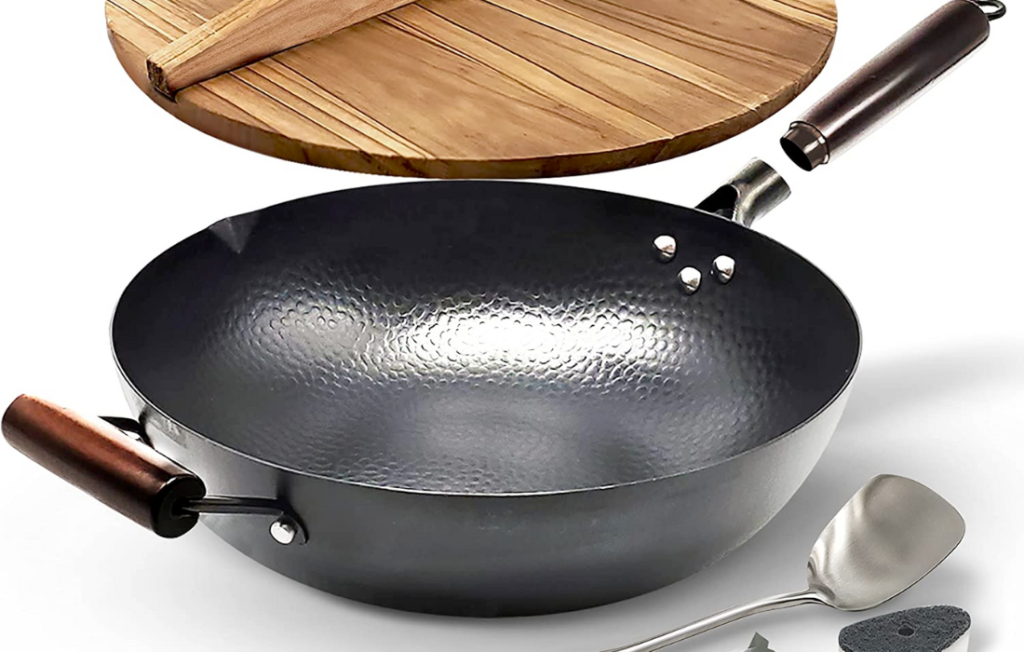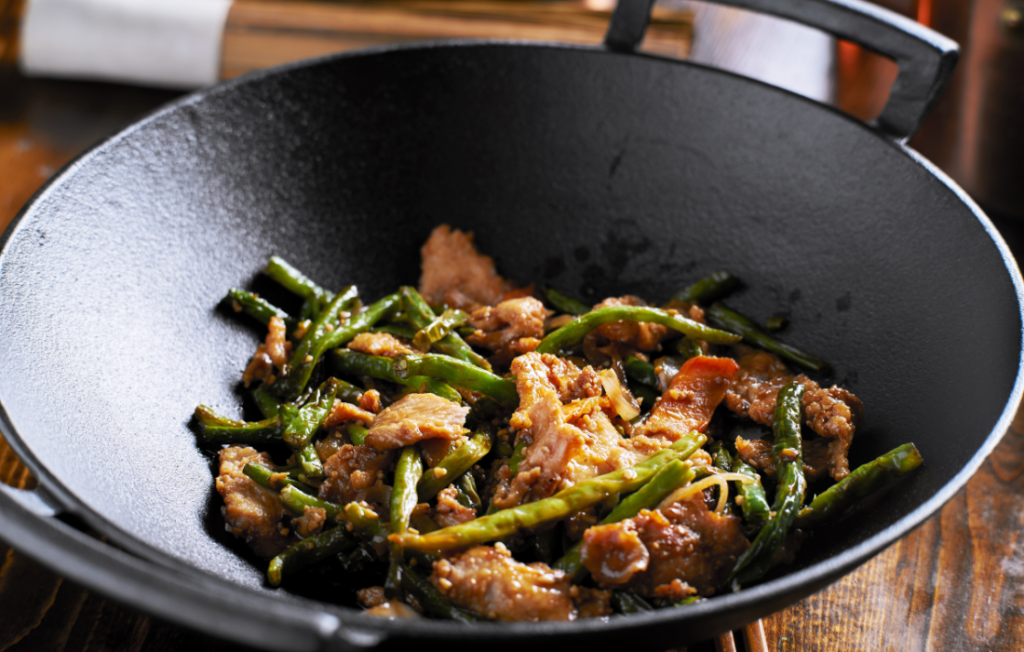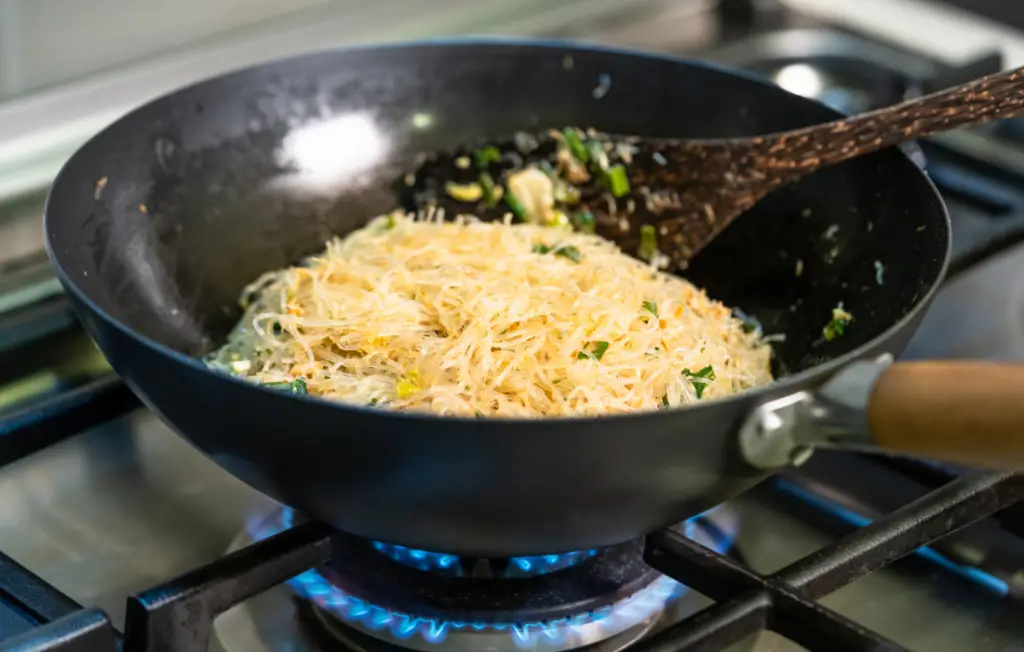Stepping into the culinary world is an adventure, especially when you discover the art of cooking with a wok. More than just a cooking pan, a wok is a versatile tool that brings out the best flavors in your food. But choosing the right wok isn’t a decision to be taken lightly. Among the contenders, cast iron and carbon steel woks have gained significant attention among cooking enthusiasts and professional chefs alike.
In this blog post, we aim to simplify the choice between a cast iron wok and a carbon steel wok. Each comes with its unique set of benefits, as well as challenges. Understanding these can be the key to mastering the art of wok cooking, whether you’re a seasoned chef or a home cook who’s just getting started. Let’s embark on this culinary journey and help you find the perfect companion for your kitchen adventures.

- Wok Fundamentals: Understanding Your Options
- Evaluating Cast Iron Woks: The Good and the Not-So-Good
- 3 Best Cast Iron Woks On Amazon
- Weighing Up Carbon Steel Woks: Advantages and Disadvantages
- Decoding the “Wok Hei”: The Breath of the Wok
- Picking the Perfect Wok for Your Kitchen: What to Consider
- Assessing the Costs: Price Range and Value for Money
- 4 Best Carbon Steel Woks On Amazon
- Preserving Your Wok’s Charm: Caring for Cast Iron vs. Carbon Steel
- Conclusion
Wok Fundamentals: Understanding Your Options
Before we delve into the differences between cast iron and carbon steel woks, let’s familiarize ourselves with the main types of woks available today:
- Cast Iron Woks: Known for excellent heat retention, but take longer to heat up and cool down.
- Carbon Steel Woks: Renowned for their fast heat up times, and even heat distribution, preferred by professional chefs for stir-frying.
- Stainless Steel Woks: Durable and easy to clean but not the best for heat conduction and distribution.
- Non-stick Woks: Convenient for low-oil cooking, but not suitable for high heat and the nonstick surface can degrade over time.
| Types of Woks | Heat Retention | Heat Distribution | Durability | Suitable for High Heat |
|---|---|---|---|---|
| Cast Iron | Excellent | Good | High | Yes |
| Carbon Steel | Good | Excellent | High | Yes |
| Stainless Steel | Fair | Fair | Very High | No |
| Non-Stick | Fair | Good | Moderate | No |

Distinguishing Cast Iron Woks from Carbon Steel Woks
While all woks share a common purpose, the main differences lie in their material. Cast iron woks, made from a heavy material, are valued for their heat retention. Once heated, they stay hot for a long time, making them excellent for slow-cooking dishes or maintaining temperature between batches.
In contrast, carbon steel woks are lighter and heat up faster, offering excellent heat distribution. This makes them an excellent choice for fast, high-heat cooking methods like stir frying. However, they don’t retain heat as long as their cast iron counterparts.
Both require seasoning and proper care to build up a natural non-stick surface and avoid rust. However, carbon steel woks are generally easier to handle due to their lighter weight and can respond to heat adjustments more quickly, providing more control during the cooking process.
Deciding between cast iron and carbon steel often boils down to your cooking style, the dishes you frequently prepare, and your personal preference. As we dive deeper into the world of woks, you’ll have a better understanding to make the right choice.
Evaluating Cast Iron Woks: The Good and the Not-So-Good
Cast iron woks have their unique set of advantages and disadvantages. Understanding these can help you decide if they are the right fit for your culinary ventures.
| Pros of Cast Iron Woks | Cons of Cast Iron Woks |
|---|---|
| Excellent heat retention, maintaining a consistent cooking temperature | Quite heavy, which can make handling and flipping food more challenging |
| Resistant to damage and can last for years with proper care | Takes longer to heat up and cool down |
| Once well-seasoned, provides a naturally non-stick surface | Can react with acidic foods, potentially influencing the flavor |
| Great for slow cooking and maintaining temperature between batches | Requires careful cleaning and maintenance to avoid rust |
From the Chefs’ Mouths: Mastering the Cast Iron Wok
Even with its drawbacks, many professional chefs swear by cast iron woks. Chef Ming Tsai, renowned for his expertise in Asian cuisine, appreciates cast iron for its unbeatable heat retention. He advises, “When using a cast iron wok, patience is key. Allow it to heat up fully before adding your ingredients. This way, you’ll achieve a beautiful sear on your food, enhancing its flavors.”
While cast iron woks require a bit of muscle and extra care, many cooks believe the flavor payoff is worth it. As celebrity chef Martin Yan says, “Nothing beats a well-seasoned cast iron wok. It imparts a special flavor, a wok hei, that you can’t get with other types of woks.” However, he reminds us that “a cast iron wok is not for everyone. It’s best for those who frequently cook and are willing to take care of it.”
Ultimately, choosing a cast iron wok comes down to understanding your cooking habits and the effort you’re willing to put into maintenance. If you appreciate slow, thoughtful cooking and cherish the complex flavors achieved through excellent heat retention, a cast iron wok could be your kitchen companion.
3 Best Cast Iron Woks On Amazon
Choosing the right cast iron wok can significantly enhance your cooking experience. Based on customer reviews, usability, and quality, here are the top five cast iron woks available on Amazon:
| SiteStripe Image | Title | Buy |
|---|---|---|
 | Lodge BOLD 14 Inch Seasoned Cast Iron Wok | Buy on Amazon |
 | Homeries Pre-Seasoned Cast Iron Wok with 2 Handled and Wooden Lid | Buy on Amazon |
 | WANGYUANJI Cast Iron Wok Pan | Buy on Amazon |
Weighing Up Carbon Steel Woks: Advantages and Disadvantages
Carbon steel woks bring their own list of benefits and shortcomings to the table. By acknowledging these, you can determine if they’re the appropriate choice for your cooking adventures.
| Pros of Carbon Steel Woks | Cons of Carbon Steel Woks |
|---|---|
| Excellent heat distribution for uniform cooking | Requires seasoning to achieve a non-stick surface |
| Lighter weight allows for easy handling and flipping of food | Can rust if not dried properly after cleaning |
| Heats up and cools down quickly, providing control over the cooking process | Doesn’t retain heat as long as cast iron woks |
| Suitable for high heat cooking, perfect for quick stir frying | Longevity may be less than cast iron with rough handling |
| Requires less oil once well-seasoned, promoting healthier cooking | Needs regular care and maintenance to keep in good condition |
Tips from the Pros: Navigating the Carbon Steel Wok
Carbon steel woks are favored by many professional chefs due to their responsiveness to heat changes and uniform heat distribution. According to acclaimed chef Ken Hom, “A carbon steel wok is an indispensable tool for stir frying. Its ability to heat up quickly and evenly makes it perfect for creating crispy, yet tender stir-fried dishes.”
However, they require a level of care to prevent rusting and maintain their non-stick surface. As celebrity chef Ching-He Huang advises, “After cooking with a carbon steel wok, clean it with warm water and a soft sponge. Avoid harsh detergents. Then, dry it thoroughly over low heat and lightly coat it with oil before storing. This keeps it in prime condition.”
If you’re a fan of stir frying and want a wok that can heat up and cool down quickly, giving you maximum control over your cooking, a carbon steel wok may be your new kitchen sidekick. Just remember, as with any wok, the love and care you invest in its maintenance will pay off in years of delicious dishes.

Decoding the “Wok Hei”: The Breath of the Wok
“Wok Hei” translates to “breath of a wok,” a phrase used to describe the complex smoky flavor achieved through wok cooking. This unique taste is a result of the Maillard reaction that occurs when food is cooked over high heat in a well-seasoned wok. It’s a characteristic most sought after in dishes like stir fries and fried rice.
Both cast iron and carbon steel woks can produce the coveted wok hei. However, they do so differently. Cast iron woks, with their excellent heat retention, can imbue dishes with deep, smoky flavors, especially when cooking for extended periods. On the other hand, carbon steel woks, due to their swift heat-up times and superior heat distribution, can help achieve wok hei in quick stir fry dishes.
Picking the Perfect Wok for Your Kitchen: What to Consider
Choosing between a cast iron and carbon steel wok doesn’t have to be overwhelming. Here are some considerations to help you select the best fit:
- Heat Source: Cast iron woks work well on gas stoves due to their heat retention properties. They’re also suitable for induction stoves, thanks to their flat-bottomed variants. Carbon steel woks, on the other hand, are suitable for all kinds of stoves, including gas, induction, and electric, given their even heat distribution.
- Amount of Food: If you regularly cook for a large group, a cast iron wok may be better, as it retains heat between batches. For smaller, quick meals, a carbon steel wok might be the better option.
- Personal Preference: Consider your cooking style. If you enjoy slow, flavor-building cooking, go for a cast iron wok. If you prefer quick, high-heat cooking like stir frying, a carbon steel wok could be the better choice.
| Considerations | Cast Iron Wok | Carbon Steel Wok |
|---|---|---|
| Heat Source | Gas and Induction | Gas, Induction, Electric |
| Quantity of Food | Large batches | Small to medium batches |
| Cooking Style | Slow cooking | Quick, high-heat cooking |
Remember, the right wok for you depends on your specific cooking needs and personal preferences. Both cast iron and carbon steel woks have their merits. It’s all about finding the one that complements your kitchen and cooking style best.
Assessing the Costs: Price Range and Value for Money
When choosing between a cast iron and carbon steel wok, it’s not just about the immediate price tag; consider the value it offers in terms of durability and longevity.
Cast Iron Woks: These tend to be more expensive than their carbon steel counterparts. However, they’re incredibly durable, and with proper care, can last for generations. This makes them a worthy investment if you’re a regular cook who appreciates their heat-retaining properties and are willing to put in the effort to maintain them.
Carbon Steel Woks: Generally, these are more budget-friendly, making them a popular choice for home cooks and beginners. While they may not last as long as cast iron with rough handling, they still offer excellent durability if well-maintained. Given their swift heat-up times and versatility across heat sources, they provide excellent value for money, especially for those who prefer quick, high-heat cooking.
In the end, the best value for your money depends on your cooking style, frequency of use, and the care you’re willing to put into maintaining your wok. While both types can offer excellent value, the carbon steel wok might be a more cost-effective choice for beginners or those on a tighter budget, whereas the cast iron wok could be a valuable long-term investment for regular cooks and food enthusiasts.
4 Best Carbon Steel Woks On Amazon
| SiteStripe Image | Title | Buy |
|---|---|---|
Top | YOSUKATA Carbon Steel Wok Pan | Buy on Amazon |
 | Todlabe Nonstick Wok, 13-Inch Carbon Steel Wok Pan | Buy on Amazon |
 | oyce Chen , Classic Series Carbon Steel Wok | Buy on Amazon |
 | kaqinu Carbon Steel Wok Pan | Buy on Amazon |
Preserving Your Wok’s Charm: Caring for Cast Iron vs. Carbon Steel
Wok care is an essential part of wok ownership. Whether you opt for a cast iron or a carbon steel wok, knowing how to look after it can prolong its life and improve your cooking experience.
Preparing Your New Wok: The First Use
Before you start stir-frying or deep-frying in your new wok, it’s crucial to prepare it for its first use. Both cast iron and carbon steel woks need to undergo initial cleaning and seasoning.
Cast Iron Woks: Wash your new cast iron wok with warm water and a soft sponge to remove any manufacturer residues. Dry it thoroughly over low heat to prevent rusting.
Carbon Steel Woks: Similar to cast iron woks, you’ll need to wash a new carbon steel wok with warm water and a soft sponge. After drying it over low heat, you’re ready to move to the next step: seasoning.
Building the Flavor Base: The Seasoning Process
The seasoning process helps to create a natural non-stick coating on your wok, enhancing its cooking properties and adding a unique flavor profile to your dishes.
Cast Iron Woks: To season a cast iron wok, apply a thin layer of vegetable oil all over the wok’s surface. Place it upside down in a preheated oven at 450°F (232°C) for an hour. Allow it to cool down in the oven. Repeat this process 2-3 times to establish a good seasoning base.
Carbon Steel Woks: The process for a carbon steel wok is slightly different. After applying a thin layer of oil, heat the wok over high heat until it begins to smoke. Lower the heat and let it sit for about 10 minutes, then let it cool. Repeat this process a few times until the wok develops a dark, glossy patina.

Preserving the Magic: Ongoing Maintenance
Proper care of your wok doesn’t stop at seasoning. Regular maintenance is key to preserving your wok’s non-stick surface and preventing rust.
Cast Iron Woks: Clean your wok after each use with hot water and a soft sponge. Avoid harsh detergents as they can strip the seasoning. Dry thoroughly and apply a thin layer of oil before storing.
Carbon Steel Woks: As with cast iron, avoid using detergents and instead clean with warm water and a soft sponge. Dry over low heat and apply a thin coat of oil.
By properly caring for your wok, whether it’s cast iron or carbon steel, you can look forward to years of delectable dishes cooked to perfection.
Conclusion
Choosing between a cast iron wok and a carbon steel wok isn’t a one-size-fits-all decision. Each wok has its unique strengths, whether it’s the heat retention of cast iron for slow, flavor-building cooking, or the swift heat-up times of carbon steel for quick, high-heat stir frying.
It’s all about your personal cooking style, your kitchen setup, and the types of dishes you plan to create. Whether you cook for a crowd or prefer to whip up quick meals for one or two, there’s a wok out there tailored to your needs.
Are you a fan of slow cooking, willing to invest in the longevity of a cast iron wok and relish its heat retaining properties? Or does the lightning-quick heat up time of a carbon steel wok, perfect for quick stir frying, appeal to your culinary style more? The decision rests in your hands, in your kitchen, and in your love for the art of cooking.

